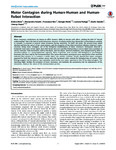Motor contagion during human-human and human-robot interaction.
| dc.contributor.author | Bisio, A | en |
| dc.contributor.author | Sciutti, A | en |
| dc.contributor.author | Nori, F | en |
| dc.contributor.author | Metta, G | en |
| dc.contributor.author | Fadiga, L | en |
| dc.contributor.author | Sandini, G | en |
| dc.contributor.author | Pozzo, T | en |
| dc.date.accessioned | 2017-06-23T15:47:13Z | |
| dc.date.available | 2017-06-23T15:47:13Z | |
| dc.date.issued | 2014 | en |
| dc.identifier.uri | http://hdl.handle.net/10026.1/9540 | |
| dc.description.abstract |
Motor resonance mechanisms are known to affect humans' ability to interact with others, yielding the kind of "mutual understanding" that is the basis of social interaction. However, it remains unclear how the partner's action features combine or compete to promote or prevent motor resonance during interaction. To clarify this point, the present study tested whether and how the nature of the visual stimulus and the properties of the observed actions influence observer's motor response, being motor contagion one of the behavioral manifestations of motor resonance. Participants observed a humanoid robot and a human agent move their hands into a pre-specified final position or put an object into a container at various velocities. Their movements, both in the object- and non-object- directed conditions, were characterized by either a smooth/curvilinear or a jerky/segmented trajectory. These trajectories were covered with biological or non-biological kinematics (the latter only by the humanoid robot). After action observation, participants were requested to either reach the indicated final position or to transport a similar object into another container. Results showed that motor contagion appeared for both the interactive partner except when the humanoid robot violated the biological laws of motion. These findings suggest that the observer may transiently match his/her own motor repertoire to that of the observed agent. This matching might mediate the activation of motor resonance, and modulate the spontaneity and the pleasantness of the interaction, whatever the nature of the communication partner. | en |
| dc.format.extent | e106172 - ? | en |
| dc.language | eng | en |
| dc.language.iso | eng | en |
| dc.subject | Adult | en |
| dc.subject | Biomechanical Phenomena | en |
| dc.subject | Emotions | en |
| dc.subject | Female | en |
| dc.subject | Hand | en |
| dc.subject | Humans | en |
| dc.subject | Interpersonal Relations | en |
| dc.subject | Male | en |
| dc.subject | Motor Cortex | en |
| dc.subject | Movement | en |
| dc.subject | Robotics | en |
| dc.subject | Young Adult | en |
| dc.title | Motor contagion during human-human and human-robot interaction. | en |
| dc.type | Journal Article | |
| plymouth.author-url | https://www.ncbi.nlm.nih.gov/pubmed/25153990 | en |
| plymouth.issue | 8 | en |
| plymouth.volume | 9 | en |
| plymouth.publication-status | Published online | en |
| plymouth.journal | PLoS One | en |
| dc.identifier.doi | 10.1371/journal.pone.0106172 | en |
| plymouth.organisational-group | /Plymouth | |
| plymouth.organisational-group | /Plymouth/Faculty of Science and Engineering | |
| plymouth.organisational-group | /Plymouth/REF 2021 Researchers by UoA | |
| plymouth.organisational-group | /Plymouth/REF 2021 Researchers by UoA/UoA11 Computer Science and Informatics | |
| dc.publisher.place | United States | en |
| dcterms.dateAccepted | 2014-08-02 | en |
| dc.identifier.eissn | 1932-6203 | en |
| dc.rights.embargoperiod | Not known | en |
| rioxxterms.versionofrecord | 10.1371/journal.pone.0106172 | en |
| rioxxterms.licenseref.uri | http://www.rioxx.net/licenses/all-rights-reserved | en |
| rioxxterms.licenseref.startdate | 2014 | en |
| rioxxterms.type | Journal Article/Review | en |


